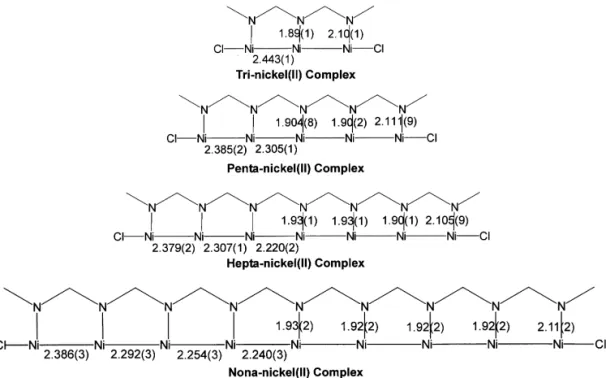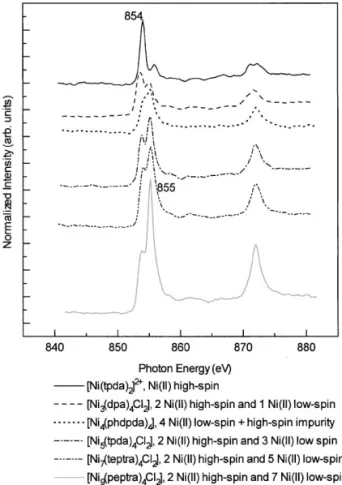* Corresponding author. Tel.: #23635357; fax: 886-2-23636359.
E-mail address: smpeng@mail.ch.ntu.edu.tw (S.-M. Peng)
Journal of Magnetism and Magnetic Materials 209 (2000) 80}83
One-dimensional metal string complexes
Shie-Ming Peng
!,",*, Chih-Chieh Wang!, Yih-Lih Jang!, Yu-Hua Chen!,
Feng-Yin Li
!, Chung-Yuan Mou!, Man-Kit Leung!
!Department of Chemistry, National Taiwan University, 1 Sec, 4 Roosevelt Road, Taipei 106, Taiwan "Institute of Chemistry, Academia Sinica, Taipei, Taiwan
Abstract
The metal string complexes with di!erent metal ions and various lengths have been successfully synthesized and structurally characterized. The crystal and molecular structure of nonanickel complex [Ni9(l9-(peptea)4Cl2] which is the longest metal string at this moment will be reported. Crystal data for [Ni9(l9-(peptea)4Cl2](C2H4Cl2)10: Space group, monoclinic C 2/c, a"27.0453(6), b"42.6678(5), c"37.4268(6) As , b"109.539(1)3, <"40702(1) As3, Z"12, RF"12% for the observed re#ections (I'2p(I)). The band structure calculation of in"nite one-dimensional metal chains of NiII and CrII based on the structure of nonanickel complex will be presented. Finally, the metal string complexes [MIInL4X2] will be chemisorbed on the Ag or Au surface and the potential application of these complexes as a molecular metal wire will be demonstrated. ( 2000 Elsevier Science B.V. All rights reserved.
Keywords: Metal}metal multiple bonds; Antiferromagnetic interaction; Metal string complexes
The metal string complexes are highly interesting in the fundamental study of metal}metal interaction [1}13] and in their potential application as molecular metal wires. In order to build up a complete bonding scheme of metal}metal multiple bonds for polynuclear metal string complexes, a series of ligands, namely oligo- a-py-ridylamine ligands, were designed and their polynuclear metal string complexes were synthesized. The oligo- a-pyridylamino ligands that have been synthesized success-fully were described as follows:
The metal string complexes shown below are those that have been synthesized successfully.
The number of metal ions successfully synthesized in these complexes is up to nine. The crystal structures of the metal string complexes from trinuclear to nonanuc-lear metal chains are essentially similar. The metal chains are co-linear with all the angles of LM}M}M being &1803 and the linear metal chain is wrapped by four all-syn type of deprotonated oligo-a-pyridylamido ligands. The crystal structure of [NiII9(l9-peptea)4Cl2]
0304-8853/00/$ - see front matter ( 2000 Elsevier Science B.V. All rights reserved. PII: S 0 3 0 4 - 8 8 5 3 ( 9 9 ) 0 0 6 5 0 - 2
Fig. 1. (a) Crystal structure of [Ni9(l9-peptea)4Cl2]. (b) Top view along the Ni axis.
Fig. 2. Comparisons of Ni}Ni and Ni}N distances among tri-, penta-, hepta- and nonanickel(II) complexes.
Fig. 3. Magnetic susceptibility measurements for tri-, penta-, hepta-, and nonanickel(II) complexes. The temperature-depen-dent magnetic susceptibility was measured on the SQUID sys-tem with a 10000 Gauss external magnetic "eld. Molar magnetic susceptibility was recorded every 5 K in the range of 5}300 K.
Fig. 4. XANES spectrum from trinickel(II) to nonanickel(II) complexes.
complex shown in Fig. 1(a) can clearly display the unique geometric conformation of these metal string complexes. The steric crowding of theb-carbon hydrogen atoms on the pyridyl rings forces the ligand to bind with the metal ion helically. Each oligo-a-pyridylamido ligand is non-planar, with an average dihedral angle among the planes of these pyridine rings of approximately 453. An end view of the molecule looking down the Ni9 axis as shown in Fig. 1(b) gives a better view of the helical structure. Our e!ort to synthesize and characterize the metal string complexes has accumulated much systematic informa-tion on the bonding characterizainforma-tion beyond dinuclear metal systems. The comparisons of Ni}Ni and Ni}N distances among tri-nickel(II) to nonanickel(II) string complexes are shown in Fig. 2. Obviously, the terminal Ni}Ni distances are longer than the inner Ni}Ni distan-ces. The magnetic measurements of nickel metal string complexes shown in Fig. 3 reveal an antiferromagnetic interaction between two terminal high-spin nickel ions in the tri-, penta-, hepta-, and nonanickel(II) complexes while the inner nickel ions are diamagnetic. The coupling constant (J) is roughly proportional to r~3, where r is the distance between two terminal nickel ions. These results are in accordance with the prediction by structural analy-sis with &2.10 As on terminal Ni}N distances and &1.90 As on inner Ni}N ones [10}12] and the XANES
measurement in Fig. 4. Two unpaired electrons that delocalize among the tri-, pentachromium(II) centers withk"3.6, 4.0, respectively, are found in the tri-, pen-tachromium(II) string complexes, which possess multi-nuclear metal}metal multiple bonds. This result is in accordance with the prediction by structural analysis and qualitative MO calculation. The electronic band struc-ture of the molecular polynuclear metal complex indi-cates that the in"nite linear Ni(II) complex is a semi-metal with a slightly "lled conduction band and the in"nite linear Cr(II) complex can probably serve as a conducting wire.
The metal complexes [MII3(l3-dpa)4(NCS)2] and [MII5 (l5-tpda)4(NCS)2] bind to the Ag or Au [1 1 1] surface to form a monolayer. The surface re#ection IR spectrum shows that one of the thiocyanates is S-bonded to the Ag or Au atom (lCN"2126 cm~1). The sulfur atom of the other thiocyanate remains uncoordinated (lCN"2063 cm~1). The potential application of these complexes as a molecular metal wire will be demon-strated. Further work will be directed towards studying the structure and conductivity of those S-bonded metal-chain complexes on the Ag and Au surfaces.
References
[1] L.P. Wu, P. Field, T. Morrisey, C. Murphy, P. Nagle, B. Hathaway, C. Simmons, P. Thornton, J. Chem. Soc. Dalton Trans. (1990) 3835.
[2] G.J. Pyrka, M. El-Mekki, A.A. Pinkerton, J. Chem. Soc. Chem. Commun. (1991) 84.
[3] M.H. Yang, T.W. Lin, C.C. Chou, H.C. Lee, H.C. Chang, G.H. Lee, M.K. Leung, S.M. Peng, Chem. Commun. (1997) 2279.
[4] F.A. Cotton, L.M. Daniels, C.A. Murillo, I. Pascual, J. Am. Chem. Soc. 119 (1997) 10223.
[5] F.A. Cotton, L.M. Daniels, C.A. Murillo, X. Wang, Chem. Commun. (1998) 39.
[6] E.C. Yang, M.C. Cheng, M.S. Tsai, S.M. Peng, J. Chem. Soc., Chem. Commun. (1994) 2377.
[7] F.A. Cotton, L.M. Daniels, G.T. Jordan, IV, Chem. Com-mun., (1997) 421.
[8] F.A. Cotton, L.M. Daniels, G.T. Jordan, C.A. Murillo, J. Am. Chem. Soc. 119 (1997) 10377.
[9] S. Aduldecha, B. Hathaway, J. Chem. Soc., Dalton Trans. (1991) 993.
[10] J.T. Sheu, C.C. Liu, I. Chao, C.C. Wang, S.M. Peng, Chem. Commun. (1996) 315.
[11] S.J. Shieh, C.C. Chou, C.C. Wang, G.H. Lee, S.M. Peng, Angew. Chem. Int. Ed. Engl. 36 (1997) 56.
[12] C.C. Wang, W.C. Lo, C.C. Chou, G.H. Lee, J.M. Chen, S.M. Peng, Inorg. Chem. 37 (1998) 4059.
[13] S.Y. Lai, Z.W. Lin, Y.H. Chen, C.C. Wang, G.H. Lee, M.H. Yang, M.-K. Leung, S.M. Peng, J. Am Chem. Soc. 121 (1999) 250.

